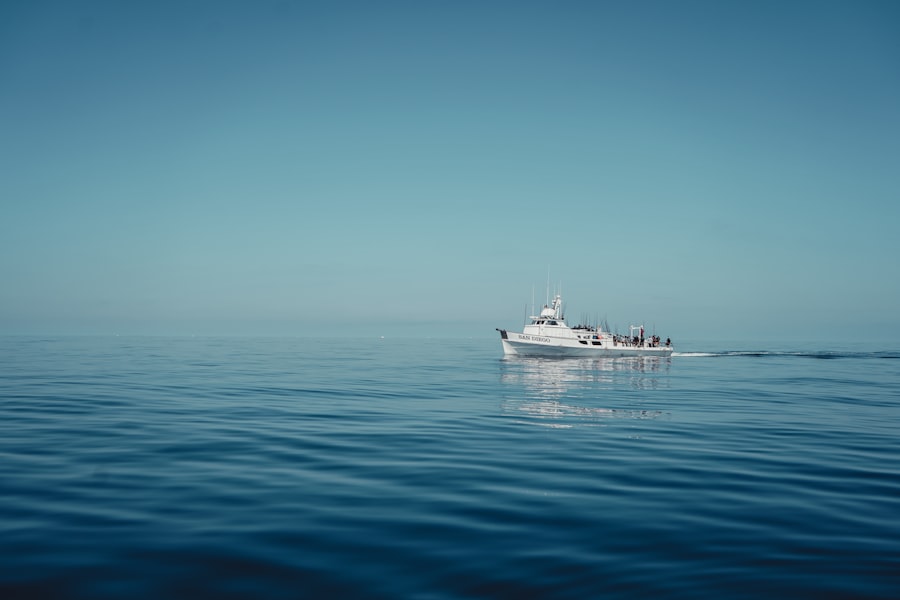Poseidon, a cutting-edge underwater drone developed by Russia, represents a significant leap in naval warfare technology. This unmanned underwater vehicle (UUV) is designed for stealthy, long-range missions, capable of traversing vast oceanic expanses while evading detection. Equipped with advanced propulsion systems and nuclear capabilities, Poseidon can deliver devastating payloads to enemy coastal installations or naval vessels, fundamentally altering the dynamics of maritime conflict.
Its ability to operate at great depths and its autonomous navigation systems make it a formidable asset in modern warfare, posing a unique challenge to traditional naval defense strategies. The capabilities of Poseidon extend beyond mere offensive operations. Its design allows for reconnaissance missions, gathering intelligence on enemy movements and infrastructure without the risk associated with manned missions.
The drone’s potential to disrupt critical maritime supply lines and threaten strategic assets has raised alarms within military circles worldwide. As nations grapple with the implications of such technology, understanding Poseidon’s operational framework becomes essential for developing effective countermeasures.
Key Takeaways
- Poseidon is a new Russian nuclear-powered, nuclear-armed underwater drone capable of carrying a 2-megaton nuclear warhead.
- The US Navy’s current underwater defense systems include sonar arrays, torpedoes, and anti-submarine warfare aircraft.
- Vulnerabilities in the US Navy’s underwater defense include the need for improved detection and tracking capabilities.
- Potential strategies for countering Poseidon include the development of advanced anti-submarine warfare technologies and international collaboration.
- Technology plays a crucial role in underwater defense, including the use of advanced sonar systems and unmanned underwater vehicles.
Current US Navy underwater defense systems
The United States Navy has invested heavily in a range of underwater defense systems to safeguard its maritime interests. These systems include advanced sonar technologies, anti-submarine warfare (ASW) platforms, and a fleet of submarines equipped with sophisticated detection capabilities. The Navy employs a multi-layered approach to underwater defense, utilizing surface ships, aircraft, and submarines to create a comprehensive network designed to detect and neutralize underwater threats.
Among the key components of the US Navy’s underwater defense arsenal are the P-8 Poseidon maritime patrol aircraft and the Virginia-class submarines. The P-8 is equipped with advanced sensors and weapons systems that allow it to conduct anti-submarine warfare missions effectively. Meanwhile, Virginia-class submarines are designed for stealth and versatility, capable of launching torpedoes and cruise missiles while remaining undetected.
Together, these systems form a robust defense against potential underwater threats, although the emergence of advanced technologies like Poseidon necessitates continuous evolution in tactics and equipment.
Vulnerabilities in the US Navy’s underwater defense

Despite its formidable capabilities, the US Navy’s underwater defense systems are not without vulnerabilities. The rapid advancement of technologies such as Poseidon highlights gaps in existing defense strategies. One significant concern is the reliance on traditional sonar systems, which may struggle to detect stealthy UUVs operating at great depths or utilizing advanced noise-reduction technologies.
This limitation could allow adversaries to exploit weaknesses in the Navy’s detection capabilities, potentially leading to catastrophic consequences. Moreover, the complexity of coordinating multiple platforms in anti-submarine warfare can create challenges in response times and situational awareness. The integration of various systems—aircraft, surface ships, and submarines—requires seamless communication and data sharing.
Any breakdown in this network could hinder the Navy’s ability to respond effectively to emerging threats like Poseidon. As adversaries continue to innovate, the US Navy must address these vulnerabilities through enhanced training, improved technology, and strategic planning.
Potential strategies for countering Poseidon
| Strategy | Description |
|---|---|
| Increased Maritime Patrols | Deploying more naval vessels to monitor and intercept Poseidon’s activities. |
| Enhanced Intelligence Sharing | Improving collaboration and information exchange among countries to better track Poseidon’s movements. |
| Technological Advancements | Investing in advanced surveillance and detection technologies to identify and respond to Poseidon’s operations. |
| International Sanctions | Implementing economic and diplomatic sanctions against countries or entities supporting Poseidon. |
To counter the threat posed by Poseidon, the US Navy must adopt a multifaceted approach that combines technological innovation with strategic foresight. One potential strategy involves enhancing existing sonar systems to improve detection capabilities against stealthy UUVs. This could include investing in next-generation sonar technologies that utilize artificial intelligence to analyze acoustic signatures more effectively.
By leveraging machine learning algorithms, the Navy could enhance its ability to distinguish between friendly and hostile underwater vehicles. In addition to technological advancements, the Navy could also focus on developing countermeasures specifically designed to neutralize UUVs like Poseidon. This might involve deploying specialized anti-drone systems capable of disrupting or disabling enemy UUVs before they can execute their missions.
Furthermore, conducting joint exercises with allied nations could foster collaboration and information sharing, allowing for a more unified response to underwater threats. By combining technological innovation with strategic partnerships, the US Navy can bolster its defenses against emerging challenges.
Role of technology in underwater defense
Technology plays a pivotal role in shaping the future of underwater defense strategies. As adversaries develop increasingly sophisticated UUVs like Poseidon, the need for advanced detection and countermeasure systems becomes paramount. Innovations in sonar technology, artificial intelligence, and unmanned systems are transforming how navies approach underwater warfare.
For instance, advancements in machine learning can enhance sonar data analysis, enabling quicker identification of potential threats and improving response times. Moreover, the integration of unmanned systems into naval operations is revolutionizing underwater defense capabilities. Autonomous vehicles can conduct surveillance missions in high-risk areas without putting personnel at risk, providing valuable intelligence on enemy movements.
Additionally, advancements in communication technologies allow for real-time data sharing between various platforms, enhancing situational awareness and coordination during operations. As technology continues to evolve, it will play an increasingly critical role in shaping effective responses to underwater threats.
International collaboration in countering underwater threats

In an era where maritime security challenges transcend national borders, international collaboration is essential for effectively countering underwater threats like Poseidon. The complexity of modern naval warfare necessitates partnerships among allied nations to share intelligence, resources, and best practices. Joint exercises and training programs can enhance interoperability among navies, ensuring that they are better prepared to respond collectively to emerging threats.
Furthermore, collaborative research and development initiatives can accelerate technological advancements in underwater defense systems. By pooling resources and expertise, nations can develop innovative solutions that address common vulnerabilities. For example, joint efforts in developing next-generation sonar technologies or anti-UUV countermeasures can lead to breakthroughs that benefit all participating nations.
In this interconnected world, fostering international cooperation is crucial for maintaining maritime security in the face of evolving threats.
The importance of intelligence gathering in detecting Poseidon
Intelligence gathering is a cornerstone of effective underwater defense strategies against threats like Poseidon. Understanding an adversary’s capabilities and intentions is vital for developing proactive measures to counter potential attacks. The collection of intelligence through various means—such as satellite surveillance, human intelligence (HUMINT), and signals intelligence (SIGINT)—can provide valuable insights into enemy activities and help identify vulnerabilities.
Moreover, real-time intelligence sharing among allied nations can enhance situational awareness and facilitate quicker decision-making during crises. By establishing robust communication channels for sharing information about potential threats, navies can coordinate their responses more effectively. In an age where information is power, prioritizing intelligence gathering will be essential for staying ahead of adversaries like those operating Poseidon.
The role of unmanned underwater vehicles in defense
Unmanned underwater vehicles (UUVs) are becoming increasingly integral to modern naval operations as they offer unique advantages in surveillance and reconnaissance missions. These vehicles can operate in high-risk environments without endangering personnel while providing critical data on enemy movements and infrastructure. The versatility of UUVs allows them to perform various tasks—from mine detection to anti-submarine warfare—making them invaluable assets in contemporary naval strategy.
As adversaries develop advanced UUVs like Poseidon, the US Navy must also invest in enhancing its own unmanned capabilities. This could involve developing specialized UUVs designed for specific missions or integrating existing platforms with advanced sensors and communication technologies. By leveraging the strengths of unmanned systems, the Navy can improve its overall effectiveness in countering underwater threats while minimizing risks to personnel.
Training and readiness of US Navy personnel in countering Poseidon
The effectiveness of any defense strategy hinges on the training and readiness of personnel tasked with executing it. As the threat landscape evolves with technologies like Poseidon, the US Navy must ensure that its personnel are adequately prepared to respond to emerging challenges. This involves not only technical training on new systems but also fostering a culture of adaptability and innovation among sailors.
Regular exercises simulating scenarios involving advanced UUVs can help personnel develop critical skills needed for effective response. These training programs should emphasize collaboration among different branches of the military and allied forces to enhance interoperability during real-world operations. By prioritizing training and readiness, the US Navy can ensure that its personnel are equipped to face the complexities posed by modern underwater threats.
The impact of Poseidon on global maritime security
The introduction of advanced UUVs like Poseidon has far-reaching implications for global maritime security. As nations invest in similar technologies, the balance of power at sea may shift dramatically. The potential for stealthy attacks on critical infrastructure or naval assets raises concerns about escalation and conflict in contested waters.
Moreover, the proliferation of such technologies could lead to an arms race among nations seeking to enhance their underwater capabilities. The emergence of Poseidon also underscores the need for robust international frameworks governing naval warfare and underwater operations. Establishing norms around the use of advanced UUVs can help mitigate risks associated with miscalculations or unintended escalations during conflicts.
As countries navigate this evolving landscape, fostering dialogue and cooperation will be essential for maintaining stability in global maritime security.
Future developments in underwater defense technology
Looking ahead, future developments in underwater defense technology will likely focus on enhancing detection capabilities and improving response strategies against emerging threats like Poseidon. Innovations in artificial intelligence will play a crucial role in analyzing vast amounts of data generated by sonar systems and other sensors, enabling quicker identification of potential threats. Additionally, advancements in materials science may lead to the development of more stealthy submarines and UUVs that can operate undetected in hostile environments.
In conclusion, as the landscape of naval warfare evolves with technologies like Poseidon, it is imperative for nations to adapt their strategies accordingly. By prioritizing technological innovation, international collaboration, intelligence gathering, and personnel training, countries can enhance their defenses against emerging underwater threats while ensuring maritime security for future generations.
In the ongoing discussion about the capabilities of the U.S. Navy to counter advanced threats, an insightful article titled “Can the U.S.
” delves into the strategic implications of this challenge. For a deeper understanding of the Navy’s current strategies and technologies, you can read more in this related article: Can the U.S. Navy Stop Poseidon?. This piece provides a comprehensive analysis of the Navy’s readiness and potential responses to emerging maritime threats.
WATCH THIS! The Secret Russian Weapon That Terrifies NATO
FAQs
What is Poseidon?
Poseidon is a nuclear-powered and nuclear-armed unmanned underwater vehicle (UUV) developed by Russia. It is designed to be capable of carrying a nuclear warhead and traveling at high speeds underwater.
Can the US Navy stop Poseidon?
The US Navy has advanced anti-submarine warfare capabilities, including sonar systems, torpedoes, and anti-submarine aircraft, which could potentially be used to detect and neutralize Poseidon. However, the effectiveness of these measures against a highly advanced and stealthy UUV like Poseidon is uncertain.
What are the challenges in stopping Poseidon?
Poseidon’s high speed and stealth capabilities make it difficult to detect and track. Additionally, its nuclear propulsion system allows it to operate for extended periods without the need for resupply, making it a challenging target for the US Navy to stop.
What measures is the US Navy taking to counter Poseidon?
The US Navy is continuously developing and upgrading its anti-submarine warfare capabilities to counter emerging threats like Poseidon. This includes investments in advanced sonar systems, underwater drones, and other technologies to improve its ability to detect and neutralize stealthy underwater threats.
Is there international cooperation to address the Poseidon threat?
The US has been working with its allies and partners to address the evolving threat posed by advanced underwater vehicles like Poseidon. This includes joint exercises, information sharing, and collaborative research and development efforts to enhance collective anti-submarine warfare capabilities.




